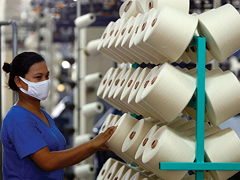More support policies needed for fiber industry
25/03/2024 08:24

The raw material production industry has been facing difficulties over the past 18 months. In particular, the fiber industry worldwide is at a loss, not just in Việt Nam.
Lê Tiến Trường, chairman of the Board of Directors of Việt Nam National Textile and Garment Group (Vinatex) raised issues surrounding credit and exchange rates.
He said accessing capital was easy in 2022, it was more difficult last year, and is now even harder due to the 2024 credit limit for fiber industry enterprises.
Currently, all banks are cutting loan limits with fiber companies, or requiring 100 per cent collateral for short-term loans this year.
The overall value of this collateral for loan is only about 20 per cent last year, but this year the requirement is 100 per cent.
For the current fiber group, many units borrow about 7 per cent from State-owned joint stock commercial banks, about 9 per cent from non-State-owned joint stock commercial banks. This is about interest rate and credit policy.
Regarding other support policies, currently countries like China are maintaining very strong support for electricity prices.
For the fiber industry, China is currently applying 4 cents/kw, only 50 per cent of Việt Nam's and applying a 50 per cent support for domestic transportation prices, when it opened until now from March 1 last year.
"Without the support of banks, the direction of the Government and ministries and branches, we may lose the fiber industry," Trường said.
The country’s fiber industry currently has 10 million spindles. The asset value as new investment is about $6 billion, the remaining value is about $3 billion and is currently paying the bank about $300 million every year.
If we reduce the limit, it may sound safe in the short term, but in fact it will be unsafe in the long term because without production, there will be no money to repay previous long-term loans. Currently the annual payment is 300 million. If the short term affects the long term, it is not necessarily a debt.
This is the story of the global economic cycle, said Trường, fiber businesses are all the same, so they need to continue to support fiber businesses this year, without reducing credit limits and not require fixed collateral, to maintain production return to their mobilisation rate.
Difficultiesy with exchange rates
With exchange rate policy, the Vinatex leader said that in the past two years, the exchange rate has only decreased by five per cent, the export industries are facing many difficulties compared to other countries.
"We don't dare say how much it should be reduced, but perhaps 5 per cent is not enough and it will be difficult for export industries to recover," Trường said.
Major textile and garment exporting countries such as China, Việt Nam, India, Bangladesh, and Turkey all tend to stimulate exports in 2022 and 2023.
In the two years 2022 and 2023, the country that will depreciate its currency the most is Turkey (50 per cent decrease); followed by Bangladesh down 21 per cent in two years, China down 11 per cent from 6.2 yuan to 7.2 yuan, and Việt Nam about more than three per cent.
In terms of exchange rate correlation alone, in 2022 and 2023, Việt Nam's textiles and garments in general will be about 15 per cent more expensive than other countries in the top five.
"That is also one of the reasons why in 2022 and 2023, the textile and garment export industry will decrease by up to 10 per cent, and is the largest decrease among the five textile and garment exporting countries," said Trường.
Source:Viet Nam News
Các tin khác
- Exports face challenges despite enjoying robust growth (26/04/2024)
- Vietnam ranks fifth among aquatic product suppliers for Singapore (26/04/2024)
- Some firms likely to close due to higher anti-dumping tariff on plywood products in S Korea (26/04/2024)
- Foreign businesses increasingly seek export sources in Vietnam (26/04/2024)
- Japan's investigation into China's graphite electrodes to 'affect regional cooperation' (26/04/2024)
 Home
Home
 About Us
About Us




















